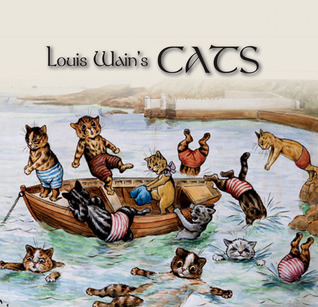Louis Wain would have been important if he had only been the greatest master ever of cute and anthropomorphic felinity, which, around the turn of the 20th Century, he was. His images of kitties were cranked out and reproduced in vast numbers, creating an inexhaustible reservoir of catty charm.
Wain would have been important if he were only known for the increasingly bizarre and (before the term was coined) psychedelic cat images he produced toward the end of his life while institutionalized as a schizophrenic.
And Wain would have been fascinating if only for the ceramic cats he designed in the teens of the 20th Century, including the Lucky Futurist Cat and other modernist triumphs from this master of popular illustration.
That Wain’s art was a rare combination of the charming, the brilliant and the bizarre this volume illustrates very well, even if it’s a little light on some of the hard facts that would provide a clearer picture of how Wain’s art evolved and why.
I first became aware of Wain in grade school while reading the Time/Life book on The Mind, which used three of his later, hallucinatory cat pictures to illustrate progressive psychosis. Chris Beetles, author of Louis Wain’s Cats, implies that this traditional diagnostic interpretation of the late work is too pat. It’s indeed possible that Wain’s images became more vibrant and more abstract because he was no longer producing them for the public, and he had the time to let his imagination run wild — not necessarily because he was getting sicker. It would be really interesting to grasp the circumstances of the later work, but Beetles provides pretty scant detail, and not enough dates to demonstrate a progression in the work, or a lack thereof.
Whatever the genesis of the wild imagery, however, it fixed in my mind from an early date that there might be something really cool in the art of the insane, making me highly receptive to Jean Dubuffet’s notion of art brut when I came across it many years later.
All in all, Louis Wain is an artist who bears investigating, and this is a good place to start, along with Rodney Dale’s earlier book, Louis Wain: The Man who drew Cats. Dale also contributes a chapter to Beetles’ volume.

